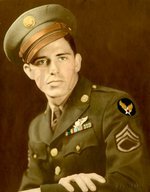
|

|
|
|
|
He was born in Shreveport, the youngest of three children of Milton Riley Harper and Mary Elizabeth Haggard Harper. James' father, nicknamed "Hoss," played semi-pro baseball, and worked as a blacksmith and toolmaker at a glass factory. They lived on Harper's Landing at Cross Lake. "We used to catch fish and hunt rabbits during the Depression. That's how we ate," James recalls. James graduated from Fair Park High School in May of 1942, and joined the U.S. Army Air Forces later that year. He took basic training at Keesler Field in Biloxi, then went on to gunnery schools in Las Vegas and at Camp Patrick Henry in Virginia. Assigned to a B-17, he was sent to Tunis, North Africa after sailing from New Jersey to Casablanca aboard the USS General William Mitchell (AP-114). Assigned to the 346th Bombardment Squadron, 99th Bombardment Group, 15th Air Force, he flew his first mission over Foggia, Italy. "We flew over and dropped our bombs and went back and loaded up and went back again," he recalls. The flak "was so thick you felt like you could just get out and walk on it," he says. The squadron lost three B-17s that day. Most bombing missions lasted "anywhere from five to nine hours," he recalls. James flew his first eight missions as a waist gunner, then replaced the tail gunner who was killed. He flew one mission in the ball turret, where he says he fit "with my knees into my ears." James finished 50 missions in six months, earned ten air medals with oak leaf clusters, and returned to the States on January 30, 1944. He was sent to Miami Beach for rest and recuperation for 45 days. As a child he met Doris Redus on a date in Alabama, where the Harpers were visiting family. They married April 8, 1944. They would have three children, five grandchildren, and four great-grandchildren. James later served as a skeet instructor (a preliminary training for gunnery) at MacDill Field in Tampa, then reported to Sheppard Field in Wichita Falls, Texas, where he was issued new clothes. Asked where he wanted to be stationed for the rest of the war, he chose Selman Field in Monroe, Louisiana, where he again was a skeet range instructor. He was discharged at Camp Shelby on September 10, 1945 as a staff sergeant. |


